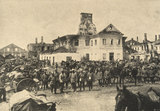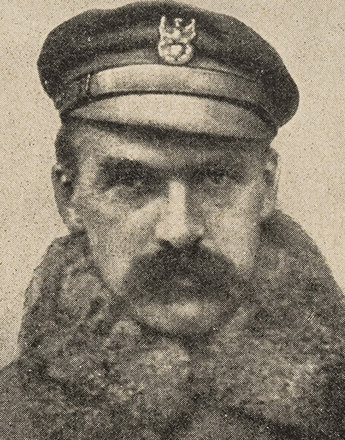-
Story Poles and Ruthenians
The Poles in the First World War: a Nation as Football for the Great Powers
The Poles were directly affected by the events of the war; the Polish territories both inside the Habsburg Monarchy and those under German and Russian rule became theatres of war for many years. From the Polish perspective, the First World War was a conflict between the three Partition powers, which now started to negotiate offers for Poland’s future status.
In August 1914 the Russian Grand Duke Nicholas held out the prospect of a free Poland in order to win support among the Poles under Austrian and German rule. However, the initial positive reactions gave way to disappointment in view of the meagre real value of the agreement.
An approach was also made on the part of the Central Powers in order to defuse the smouldering trouble spot that was Poland. The Habsburg Monarchy was able to hitch onto the traditional, pro-Austrian position of the Polish National Committee formed in August 1914, which was under the leadership of the conservative élite of the Poland Club in the former Imperial Council. Headed by the officer Józef Piłsudski (1867–1935) Polish legions were formed to fight on the side of the Central Powers against Russia. The idea was born of a Polish buffer state next to Russia. But the measure of sovereignty due to this state was a matter of controversy. The German-national wing and also the German military command tended to see Poland as a future German colonisation region. Some of the Austrian political powers-that-be, including Emperor Franz Joseph, ventilated the possibility of uniting Galicia with Congress Poland in order to create a Polish state headed by Austria, which as third part-state would have transformed the Dual Monarchy of Austria-Hungary into a trialistic configuration. But this was rejected by both the German Austrians and the Magyars, since the numerically strengthened Poles would have put the previous hegemony of the two leading “nation peoples” of the Dual Monarchy into question. Nevertheless, the Viennese offer of a Polish trialism within Austria was in any case maintained on paper at first, because Austria had to concede great territorial losses in Galicia at the start of the war.
It was not until the end of 1915 that the armies of the Central Powers managed to bring extensive parts of Russian Poland under their control. In order to secure Polish loyalty, Austria and Germany declared in November 1916 that Poland should be resurrected in the form of a monarchy, but restricted to the former Russian section, since the Polish territories under German and Austrian rule should not become involved. This Polish state would avail of its own army, but would de facto remain on the leash of the Central Powers. Archduke Karl Stephan was elected as regent of this Polish kingdom, a scion of the Habsburgs with estates in Galicia and associated with the Polish national movement. But in many cases promises remained empty. A regency council with its seat in Warsaw was set up as government of the virtual state (“Regency Kingdom”); in reality the country continued to be controlled by the military administration of the allied German-Austria Army and economically squeezed out through massive requisitioning.
In view of the hesitancy of Vienna and Berlin in the Polish cause, the political representatives of the Poles turned away from the Central Powers and, after the fall of the Tsar in February 1917, started to cooperate with the new power centre in Russia, which acknowledged the Poles’ right to self-determination. Now the Western Powers could be won as well for the Polish agenda; they had held back until then out of consideration for Russia. In summer 1917 a National Committee was formed in Lausanne by the representatives of the Poles in exile headed by Roman Dmowski (1864–1939); this was acknowledged by the Western Powers as sole representation of the Polish nation.
This meant that the Poles, in comparison with the other non-sovereign peoples of Central Europe, had come furthest in fulfilment of their demands, since both blocks in principle acknowledged the re-establishment of a Polish state. But the problem was that although the Poles found most support in the western states of the Entente, the Polish territories were completely under the military control of the Central Powers.
Finally, at the end of the war, it came to pass: on 7 October 1918 the Regency Council in Warsaw declared the independent Polish state and claimed the lands of the historical Polish kingdom before the partitions of 1772 to 1795 as state territory. State formation was overshadowed by the inner conflicts of the political camps. Eventually the commander-in-chief of the Polish Army Józef Piłsudski assumed leadership. His regime evinced a strong militaristic and authoritarian character, also because of the armed conflicts over the borders of the reborn state which lasted until 1921. In 1919 Poland was acknowledged as a republic by international law in the Treaty of Versailles. Out of the massed bankruptcy of the fallen Habsburg Monarchy it was assigned the whole of Galicia (regardless of the strong Ukrainian share of the population), and the Polish-speaking parts of Austrian Silesia.
Translation: Abigail Prohaska
Batowski, Henryk: Die Polen, in: Wandruszka, Adam/Urbanitsch, Peter (Hrsg.): Die Habsburgermonarchie 1848–1918, Band III: Die Völker des Reiches, Wien 1980, Teilband 1, 522–554
Hoensch, Jörg K.: Geschichte Polens. (3. Auflage), Stuttgart 1998
Křen, Jan: Dvě století střední Evropy [Zwei Jahrhunderte Mitteleuropas], Praha 2005
Rauchensteiner, Manfried: Der Erste Weltkrieg und das Ende der Habsburgermonarchie 1914–1918, Wien u. a. 2013
Rumpler, Helmut: Eine Chance für Mitteleuropa. Bürgerliche Emanzipation und Staatsverfall in der Habsburgermonarchie [Österreichische Geschichte 1804–1914, hrsg. von Herwig Wolfram], Wien 2005
-
Chapters
- Poles and Ruthenians in the Habsburg Monarchy
- At the Margins of the Empire: Galicia and Bukovina
- The struggle of the Poles for their nation: Poland is not yet lost!
- Compromise with Vienna: Polish Autonomy in Galicia
- The Poles in the First World War: a Nation as Football for the Great Powers
- The Great Unknown: The Ruthenians
- Approach and Rejection: The Ruthenians between Austria and Russia







